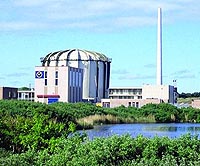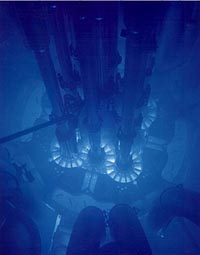Highlights
RERTR program reduces use of enriched uranium in research reactors worldwide

READY TO CONVERT – The High Flux Reactor in Petten, the Netherlands, has begun its conversion from HEU fuel to LEU. Photo courtesy of NRG.
ARGONNE, Ill. (Feb. 24, 2006) — Argonne National Laboratory provides overall technical integration for the Reduced Enrichment for Research and Test Reactors (RERTR) program, managed by the U.S. Department of Energy's National Nuclear Security Administration (NNSA) to convert research and test reactors across the globe to low enriched uranium (LEU) fuel – a material that cannot be diverted for direct use in nuclear weapons.
The program's primary objective, said Jordi Roglans-Ribas of Argonne's Nuclear Engineering Division, “is to develop the technology to minimize and, to the extent possible, eventually eliminate the use of highly enriched uranium (HEU) in civilian nuclear applications worldwide.” Roglans-Ribas manages the the RERTR program at Argonne.
Initiated in 1978, the RERTR program has long relied on Argonne's skills as a world leader in designing reactors and developing nuclear fuel. The RERTR program has provided alternative fuel technology to foreign countries in exchange for their pledge to forgo using HEU fuel in their research reactors. Argonne performs the technical integration management of the program for DOE and works closely with the Department of State, the Nuclear Regulatory Commission, and international organizations such as the International Atomic Energy Agency.
There are more than 150 research reactors around the world that still use HEU fuel. Research reactors have been built at universities and national research centers in the United States and other countries, including Kazakhstan, China, Russia, Ghana, Libya and the Netherlands. These small reactors play a vital role by providing neutrons for basic research, nuclear fuel testing, cancer therapy, medical isotope production and improved pharmaceuticals.
“It is important to ensure that research reactors can continue to perform these very important functions while provisions are made to avoid the dangers of nuclear proliferation,” Roglans-Ribas said.
Fuel facts

RERTR FUEL TESTS – As part of the advanced fuel development program for RERTR, fuel samples are being tested in Department of Energy's Advanced Test Reactor at Idaho National Laboratory. Click on photo to view a larger image.
Argonne developed higher density LEU fuel that replaces the HEU fuel in research reactors. The LEU fuel uses four times the amount of uranium – but the increase is in uranium-238. The resulting LEU fuel, unlike the HEU, would be very difficult to use in bombs. These fuels are suitable for the conversion of a significant number of reactors. The program continues to develop higher density fuels — a joint effort by Argonne and the Idaho National Laboratory— to enable the conversion of additional research rectors to LEU fuels.
Since the RERTR program began, 43 HEU reactors in 23 countries from Argentina to Turkey have been modified to run on LEU or are currently operating with a mixed load of HEU and LEU fuel. The program develops the appropriate LEU fuels and provides analysis support, technical expertise and oversight during conversion. The recipient country generally bears the conversion costs, but under the Global Threat Reduction Initiative, NNSA is developing a system of incentives to encourage conversion.
Another 66 reactors are prime candidates for conversion from HEU to LEU fuel.
Finesse, not just fuel
The RERTR program involves much more than computer analysis, fuel research and installation; it takes a lot of work to convince researchers that LEU fuel is essentially as good as HEU and much safer for the world. And working with some countries can be difficult.
The RERTR program celebrated a major victory in 2004 when Libya announced its intention to adhere to the Nuclear Non-Proliferation Treaty and convert its two research reactors to LEU fuel. Libya pledged to “eliminate all materials, equipment and programs leading to the production of internationally proscribed weapons – including nuclear weapons,” according to the International Atomic Energy Agency.
The IAEA, the United Nations' nuclear watchdog agency, will inspect Libya's reactors twice a year to verify compliance. By accepting RERTR's terms, Libya can use its nuclear research reactors for peaceful purposes while assuring the international community it is not seeking to acquire nuclear weapon capabilities.
Future focus
Now that RERTR is a key program in the NNSA's Global Threat Reduction Initiative (GTRI), Argonne researchers hope to support GTRI efforts to quicken the pace of reactor conversions. RERTR's future is busy. Researchers will :
- Collaborate with Russian organizations to convert Russian-supplied research reactors in other countries,
- Support U.S. universities to convert their reactors,
- Develop advanced fuel to convert reactors that cannot use currently qualified LEU fuel, and
- Demonstrate the use of LEU targets to produce molybdenum-99 for medical applications.
— Evelyn Brown
[ More News ]
Last Modified: Wed, April 20, 2016 9:33 AM


